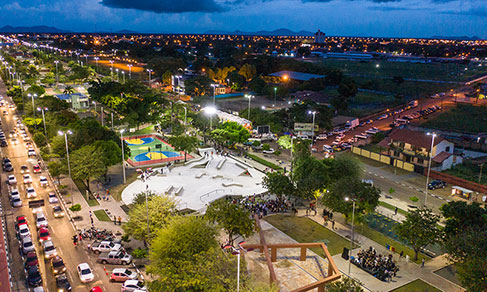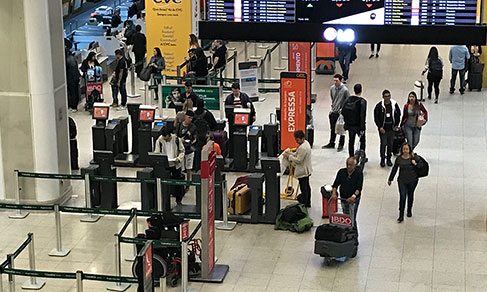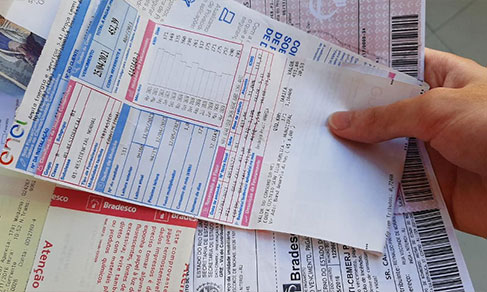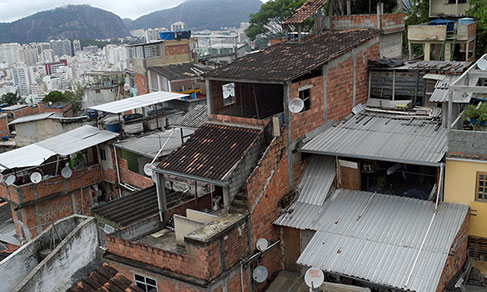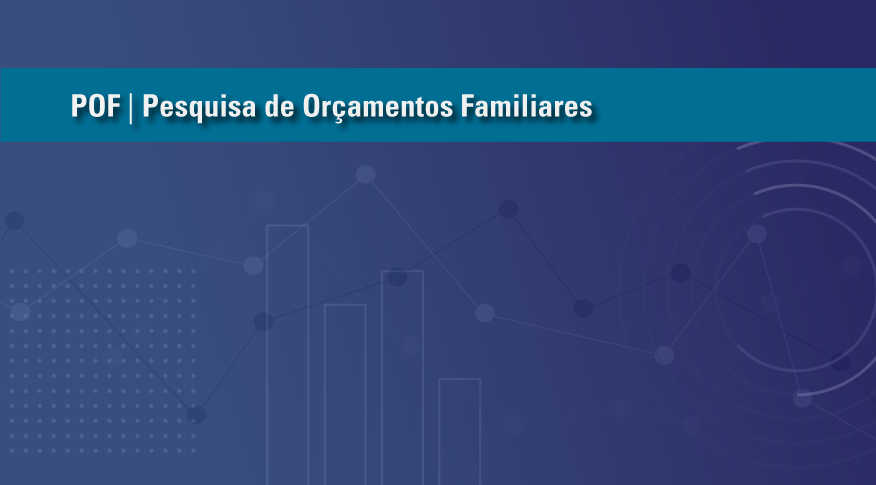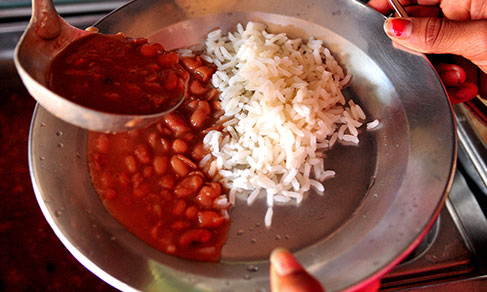Nossos serviços estão apresentando instabilidade no momento. Algumas informações podem não estar disponíveis.
POF - Consumer Expenditure Survey
 Experimental Statistics
Experimental Statistics
About - Evolution of Non-Monetary Indicators of Poverty and Quality of Life in Brazil based on the Consumer Expenditure Survey
The Consumer Expenditure Surveys (POFs), carried out by the IBGE, aim at making information available on the composition of household budgets and on the Brazilian population’s living conditions, including self-perceived quality of life. It also generates database and studies on the population’s nutrition profile.
The results of POF 2017-2018 produced studies on the nutritional assessment of the household availability of food, personal food intake and food security, as well as on the profile of expenditures in Brazil, based on selected indicators, peaking with the assessment of the population´s quality of life, for the first time accomplished under the perspective of two indexes of multidimensional losses or deprivations. To do this, the Loss of Quality of Life Index (IPQV) and the Socio-Economic Performance Index (IDS) were built, as well as a time analysis of their evolution based on the results of POF 2008-2009. As they are new statistics, still in the test phase and under assessment, such indicators were released as Experimental Investigations.
The IPQV and the IDS were obtained from a comprehensive set of non-monetary and subjective indicators, according to the six dimensions of analysis: housing, access to public utility services, health and food, education, access to financial services and standard of living, and transportation and leisure. These dimensions were also used to measure poverty and vulnerability of the population through three new indexes: the Non-Monetary Multidimensional Poverty Index (IPM-NM), the Non-Monetary Multidimensional Vulnerability Index (IVM-NM) and the Multidimensional Poverty Index with Relative Component (IPM-CR), addressed in this experimental study. The results, also compared with those of POF 2008-2009, are part of the assessment of quality of life previously released and are presented by geographic division, by variables associated to eligibility to social interaction and to engage in economic activities, such as schooling, as well as by variables relative to the insertion of the household head in the labor market.
The technical notes enclosed in the publication summarize the general procedures used in the survey´s data collection and handling and describe the conceptual framework and the methodological model applied to those dimensions and the construction of the indexes, among other considerations of methodological nature.
As with the previous publications, the present one can be accessed on the IBGE portal, which also makes available the collection instruments used in both editions of the survey, as well as its microdata, in order to streamline the use of such databases according to different purposes.
 Experimental Statistics
Experimental Statistics
Tables - Evolution of Non-Monetary Indicators of Poverty and Quality of Life in Brazil based on the Consumer Expenditure Survey
Tables
Evolution of Non-Monetary Indicators of Poverty and Quality of Life in Brazil 2017-2018 ( xls | ods )
Evolution of Non-Monetary Indicators of Poverty and Quality of Life in Brazil 2008-2009 ( xls | ods )
 Experimental Statistics
Experimental Statistics
Concepts and methods - Evolution of Non-Monetary Indicators of Poverty and Quality of Life in Brazil based on the Consumer Expenditure Survey
As informações a seguir descrevem os metadados estatísticos, que são o conjunto de conceitos, métodos e aspectos relacionados às estatísticas, e são informações necessárias para compreender as características e a qualidade das estatísticas e interpretá-las corretamente.
Informações Gerais
Objetivo
As informações da pesquisa são utilizadas para atualizar as estruturas de ponderações, necessárias para a produção dos Índices de Preços ao Consumidor (Índices, calculados e publicados mensalmente pelo IBGE, que indicam a variação média ocorrida nos preços do conjunto de bens consumidos e de serviços utilizados pela população) e também na atualização da participação das despesas das famílias no cálculo das Contas Nacionais. Além disso, permitem estudar a evolução dos hábitos de consumo das famílias e possibilitam os mais variados estudos e planejamentos sobre: distribuição, concentração e desigualdade de renda, aspectos demográficos e socioeconômicos, quantidades adquiridas de alimentos "per capita". A partir da POF 2002-2003, além de cobrir todo o País (áreas urbana e rural), foram incluídas as aquisições de produtos realizadas pelas famílias através de aquisições não monetárias (doações, trocas, retiradas do negócio, produção própria). Também foram incluídos novos temas relacionados à nutrição, investigando as medidas antropométricas - peso e altura -, a quantidade de alimentos adquiridos no domicílio e pesquisando também aspectos sobre as condições de vida das famílias - Questionário de avaliação subjetiva das condições de vida. Na POF 2008-2009, todos os objetivos e temas descritos anteriormente foram mantidos como também a abrangência geográfica. Também, nesta pesquisa atendendo novas demandas, foram incluídas variáveis relacionadas aos temas Meio Ambiente, Turismo, Assistência à Saúde, Fecundidade e também maiores detalhamentos em relação a antropometria. Nesta versão da pesquisa, foi incluída uma primeira experiência na utilização de um modelo metodológico para investigação do consumo efetivo pessoal, definido e trabalhado em parceria com o Ministério da Saúde. Este modulo foi pesquisado através do Bloco de consumo alimentar pessoal - POF7. Na POF 2017-2018 foram mantidos os temas descritos anteriormente e a abrangência geográfica. Uma exceção é a antropometria que não foi pesquisada nessa edição da POF. Entretanto, outros tema fortemente relacionados às condições de vida são destaque nas POF 2017-2018, a exemplo da investigação subjetiva sobre a qualidade de vida das famílias e de um amplo conjunto de variáveis que é investigado para a avaliação do perfil nutricional da população residente no Brasil. Para tanto, novamente foi executado o módulo de investigação sobre consumo efetivo de alimentos, para pessoas moradoras com 10 anos ou mais de idade e, pela primeira vez nas POFs, temos a aplicação da EBIA - Escala Brasileira de Insegurança Alimenta. Cabe ressaltar aqui a relevância do tema segurança alimentar no âmbito dos ODS, onde vários indicadores devem ser atualizados a partir da disponibilidade dos dados da pesquisa.Tipo de operação estatística
Pesquisa de orçamento familiarTipo de dados
Dados de pesquisa por amostragem probabilísticaPeriodicidade de divulgação
QuinquenalPopulação-alvo
Domicílios particulares permanentes ocupados e seus moradores, na área de abrangência da pesquisa nas situações urbana e rural. Foram excuídas as áreas definidas pelo IBGE como sendo quartéis, bases militares, alojamentos, acampamentos, embarcações, penitenciárias, colônias penais, presídios, cadeias, asilos, orfanatos, conventos e hospitais.Metodologia
A seleção da amostra adotada nas pesquisas utilizou um plano amostral conglomerado em dois estágios de seleção, com estratificação geográfica e estatística das unidades de primeiro estágio. Os setores correspondem às unidades do primeiro estágio de seleção e os domicílios particulares permanentes, às unidades do segundo estágio.
Para garantir a distribuição de todos os estratos geográficos e socioeconômicos durante os doze meses, a POF foi dividida em 52 períodos de sete dias. Para cada domicílio selecionado, foram indicados aleatoriamente, dentre esses períodos, dois consecutivos em que obrigatoriamente foi iniciada a coleta.
As informações da POF foram obtidas diretamente nos domicílios particulares permanentes selecionados, por meio de entrevistas realizadas pelas Equipes Regionais do IBGE, junto aos seus moradores, durante um período de nove dias consecutivos, através da aplicação de equipamentos eletrônicos sob a forma de entrevistas e de registros diários pelo informante.
Os procedimentos metodológicos adotados para o tratamento das informações coletadas na POF são: validação na entrada de dados, tratamento do efeito inflacionário sobre as informações de valores (deflacionamento ou inflacionamento), análise do valor das despesas e rendimentos, alocação das despesas informadas na forma agregada, tratamento da não resposta de valores de despesas e rendimentos, anualização dos valores de despesas e rendimentos e o tratamento das informações de quantidades adquiridas de alimentos.
O Bloco de consumo alimentar pessoal (POF7) foi investigado em uma subamostra de domicílios selecionados, durante dois dias não consecutivos, para os moradores com 10 anos ou mais de idade, para o registro de todos os alimentos e bebidas consumidos dentro e fora do domicílio.
Técnica de coleta:
CAPI - Entrevista pessoal assistida por computadorProcedimento de amostragem
Para a POF 2017-2018, adotou-se um plano amostral denominado como conglomerado em dois estágios, com estratificações geográfica e estatística das unidades primárias de amostragem que correspondem aos setores ou agregados de setores da base geográfica do Censo Demográfico 2010, a partir da estrutura oferecida pela amostra mestra desenhada pelo IBGE para o Sistema Integrado de Pesquisas Domiciliares (SIPD). As unidades primárias de amostragem (UPAs) foram selecionados por amostragem com probabilidade proporcional ao número de domicílios existentes no setor, dentro de cada estrato final, compondo a amostra mestra. A subamostra de UPAs para a POF 2017-2018 foi selecionada por amostragem aleatória simples em cada estrato. No plano adotado, as unidades secundárias de amostragem foram os domicílios particulares permanentes, selecionados por amostragem aleatória simples sem reposição, de cada uma das UPAs selecionadas. Em seguida ao processo de seleção de UPAs e domicílios, cabe explicar que as UPAs são distribuídas ao longo dos quatro trimestres da pesquisa, garantindo que em todos eles, os estratos geográfico e socioeconômico estejam representados através dos domicílios selecionados.O tamanho da amostra de UPAs foi determinado em função do tipo de estimador utilizado e do nível de precisão fixado para estimar o total dos rendimentos das pessoas moradoras responsáveis pelos domicílios, obtidos a partir dos dados do Censo Demográfico 2010, e, ainda, levando em consideração o número esperado de domicílios com entrevistas realizadas em cada setor, segundo cada domínio de estimação considerado. Foram identificados dois níveis geográficos de controle para o cálculo do tamanho da amostra, a saber: área urbana de cada Unidade da Federação e área rural de cada Grande Região.
A seleção de UPAs para compor a amostra mestra ocorreu de forma independente em cada estrato proporcional ao número de domicílios da malha setorial do Censo Demográfico 2010. As UPAs da amostra da POF 2017-2018, por sua vez, foram selecionados a partir das UPAs da amostra mestra, através de um procedimento de seleção definido como amostra aleatória simples.
Através do procedimento explicado, foram então selecionados os 5 504 UPAs para a amostra da pesquisa, de um total de 15 096 UPAs setores pertencentes à amostra mestra. Após o procedimento de seleção das UPAs e a alocação pelos quatro trimestres da pesquisa, deu-se início ao processo de seleção dos domicílios para compor a amostra a ser entrevistada a cada trimestre.
Crítica e imputação
Crítica de Valores (despesas e rendimentos):A pesquisa coletou informações sobre os valores de despesas e rendimentos nos diversos domicílios pesquisados. No entanto, estes valores estão sujeitos a erros de coleta e transcrição. Com o objetivo de identificar tais problemas, foi necessário que esses dados fossem submetidos a uma crítica de valores.
A crítica de valores da POF pode ser subdividida em três etapas:
- Partição em classes de rendimento monetário mensal familiar;
- Procedimentos de detecção de outliers (valores extremos - altos ou baixos); e
- Crítica visual.
As partições dos dados em classes foram feitas visando criar grupos homogêneos de informações, já que as estruturas de despesas e rendimentos das unidades de consumo possuem alta correlação com a renda bruta mensal. Assim, o objetivo dessas partições é criar grupos com estruturas de gastos e rendimentos com o mesmo padrão.
A etapa da crítica mais importante é a detecção dos outliers que consiste na identificação dos valores extremos (altos ou baixos) observados na distribuição estatística de uma variável, ou seja, dados não representativos de um conjunto de observações. No caso da pesquisa, foram considerados outliers aqueles registros de despesas de um item (produto ou serviço) ou rendimentos, cujos valores, muito altos ou muito baixos, não atenderam aos critérios estatísticos estabelecidos.
A crítica visual foi feita tomando-se por base um relatório obtido após a execução do programa de crítica (resultado das duas etapas anteriores). Este relatório era composto de várias variáveis auxiliares associadas ao produto ou serviço apresentado, para a tomada de decisão sobre a aceitação ou rejeição dos valores que eram detectados pela crítica. Nas situações de rejeição dos valores pela crítica, os mesmos foram marcados para serem tratados na etapa de imputação de valores.
Tratamento da não resposta de valores de despesas e rendimentos:
Diversos tipos de erros podem afetar os resultados do levantamento. Alguns são passíveis de serem controlados como, por exemplo, o erro amostral, que é controlado quando da definição do desenho e tamanho da amostra. Outros erros surgem nas diversas fases da pesquisa e, dentre estes, destacam-se os erros de não resposta total ou parcial e erros de resposta.
Em função da complexidade da POF, situações de dados incompletos associados à não resposta ocorreram. A ausência de resposta surgiu quando ocorreu perda total ou parcial das informações relativas a despesas ou rendimentos. Perda essa motivada por fatores, tais como: a falta de contato com os informantes ou a falta de possibilidade de cooperação decorrente da carga de informações a serem coletadas, da amplitude do período a ser coletado, bem como da dificuldade de memória do respondente, entre outros.
Foi utilizado procedimento de imputação para tratar a não resposta total ou parcial. Também são tratados os erros de resposta associados a valores rejeitados na etapa de crítica.
O procedimento aqui especificado recebe o nome de hot deck e foi empregado tanto para atribuir valores nos casos de itens com valores de despesas ou rendimentos ignorados ou rejeitados pela crítica, quanto para a imputação de partes de questionários de despesas e rendimentos e questionários inteiros, de despesas e rendimentos, não preenchidos.
Temas
Temas e subtemas
Família, Grupos populacionais específicos, Rendimento, despesa e consumo, Estatísticas multidomínio, População, Condições de vida, pobreza e desigualdade, Habitação, Saúde, Proteção socialPrincipais variáveis
Domicilio: tipo do domicílio; cômodos - total, servindo de dormitórios e total de banheiros; condição de ocupação; abastecimento de água; esgotamento sanitário; origem da energia elétrica; material que predomina no piso; pavimentação na rua do domicílio; tempo de moradia; e características do aluguel.Famílias: tamanho da família; e bens duráveis (inventário), condições de vida.
Pessoas: relação com a pessoa de referência da família; condição de presença; idade; sexo; nível de escolaridade; cor ou raça; atividade/ocupação.
Orçamentos: despesa global; despesa corrente; despesa de consumo; aumento do ativo; diminuição do passivo; local de compra; despesas monetária e não monetária média mensal familiar; rendimento total; rendimento do trabalho; transferências; rendimento de aluguel; outros recebimentos; rendimento mensal domiciliar; rendimento mensal familiar; rendimento mensal pessoal e movimentação financeira.
Na POF 2017-2018 constam as seguintes variáveis relacionadas ao tema meio ambiente: localização do domicílio, separação do lixo, coleta seletiva do lixo, destino do lixo, origem da energia elétrica, fonte própria de energia elétrica, aquecimento de água, combustível utilizado no fogão.
Também foram incluídas variáveis relacionadas ao tema nutrição como alimentação escolar, consumo efetivo e a Escala Brasileira de Insegurança Alimentar (EBIA).
Unidades de informação
Unidade de investigação
Domicílio, Família, PessoaUnidade de análise
Pessoa, Domicílio, FamíliaUnidade informante
Pessoa, Domicílio.Períodos de referência
Ano - 11/07/2017 a 10/07/2018
Data de início da coleta
11/07/2017Data do fim da coleta
11/07/2018Disseminação
Formas de disseminação
Publicação Digital (online), Microdados no Portal do IBGENível de desagregação geográfica
Unidade da FederaçãoNível de divulgação
Os resultados foram produzidos para os níveis Brasil, Grandes Regiões e Unidades da Federação. Também foram produzidos resultados para Brasil áreas urbanas e rurais.Instrumentos de coleta
POF 1 - Características do Domicílio e dos Moradores
POF 2 - Questionário de Aquisição Coletiva
POF 3 - Caderneta de Aquisição Coletiva
POF 4 - Questionário de Aquisição Individual
POF 5 - Questionário de Trabalho e Rendimento Individual
POF 6 - Avaliação das Condições de Vida
POF 7 - Bloco de Consumo Alimentar Pessoal .
Histórico
A segunda pesquisa realizada no período de 1995-1996, teve a mesma abrangência da anterior e visou a atender aos mesmos objetivos.
A terceira Pesquisa de Orçamentos Familiares 2002-2003 deu igual prioridade às utilizações descritas anteriormente, além de atender a novas demandas, principalmente aquelas relacionadas a aspectos de nutrição e condições de vida. A partir desta edição a abrangência geográfica foi ampliada para todo território Nacional, cobrindo todas as áreas urbana e rural do país.
Em 2008-2009 o IBGE realizou a quarta pesquisa, que além de manter o objetivo principal - Orçamentos Familiares -, que permite obter as estruturas de consumo das famílias e também o valor total da conta família, também incluiu os temas nutrição e condições de vida, tendo um maior aprofundamento no tema nutrição. O modelo metodológico da pesquisa também atendeu diversas novas demandas, sendo incluídas diversas variáveis relacionadas a Meio Ambiente, Turismo, Assistência à Saúde e Fecundidade.
Nesta pesquisa, também foi incluída uma primeira experiência metodológica de investigação do consumo efetivo pessoal. Através de um novo questionário - Bloco de consumo pessoal individual (POF7), o consumo efetivo de alimentos e bebidas no domicílio e fora do domicílio foi investigado para uma subamostra de domicílios, .
Saiba mais
https://metadados.ibge.gov.br/consulta/estatisticos/operacoes-estatisticas/OF Experimental Statistics
Experimental Statistics
Publications - Evolution of Non-Monetary Indicators of Poverty and Quality of Life in Brazil based on the Consumer Expenditure Survey
Description
The Consumer Expenditure Survey - POF assesses the structures of consumption, expenditures, income and part of the asset variation of the households, providing a profile of the life conditions of the population based on the analysis of the household budgets. In addition to the information directly associated with the budget structure, a number of characteristics of the housing units and households are also investigated, including the subjective self-assessment of life quality. The results of the survey also allow to study the composition of the household expenditures according to the income classes, regional disparities, urban and rural status, diffusion and volume of transfers between different income classes, as well as the dimension of the consumer market for groups of products and services. The survey has the household as the investigation unit and it is based on sampling.
The 2008-2009 POF was the fifth survey carried out by the IBGE on household budget. The previous editions were: the 1974-1975 National Study of Household Expenditure - ENDEF, with a nationwide coverage, except for the rural areas of the North and Central-West Regions; the 1987-1988 POF; the 1995-1996 POF; and the 2002-2003 POF. The Consumer Expenditure Surveys of the 1980s and 1990s were conceived to primarily update the consumer structures of the consumer price indexes produced by the IBGE, being accomplished in the Metropolitan Areas of Belém, Fortaleza, Recife, Salvador, Belo Horizonte, Rio de Janeiro, São Paulo, Curitiba and Porto Alegre, in the Municipality of Goiânia, and in the Federal District. Besides covering the entire Brazilian territory, the POFs of the 2000s included additional subjects over the previous editions, due to the need of detailed information on the life conditions based on the consumption, particularly of the households with lower income, the reason why the rural area was included in the geographic coverage and the non-monetary purchases were also investigated.
The current sample design of POF was structured in such a way that it releases the results at the following levels: Brazil, Major Regions and also by urban or rural status. The results include the totals and the urban situation for the Federation Units. The results correspond to the urban situation in the nine Metropolitan Areas and Municipalities of the Capitals. As of the project called Master Sample, developed by the IBGE to implement the Integrated System of Household Surveys - SIPD, the Consumer Expenditure Surveys had the sample design defined by the Master Sample, and its sectors selected among those from that sample.
Microdata
2017-2018
Updated on 3/4/2021
- Data
- Documentation - updated on 04/23/2021
- Questionnaires - updated on 04/23/2021
- Table Translators
- Reading Software
- Calculation Memory
- Readme
2008-2009
- Data - updated on 10/05/2021
- Documentation - updated on 10/05/2021
- Questionnaries
- Table Translators
- Manual of the Survey Agent
- Readme
2002-2003
Downloads
Technical Information
Methodological considerations on the Consumer Expenditure Survey can be obtained in the Technical notes chapter of its results publication.
News and Releases
POF 2017-2018
Three new indexes show drop of poverty and vulnerability between 2008-2009 and 2017-2018
For the first time ever, the IBGE releases, as experimental statistics, the Evolution of Non-Monetary...
25/08/2023
POF 2017-2018
POF: Socioeconomic performance index for Brazil grows 12.8% between 2008 and 2018
The IBGE released today (23) an updating of the indicators that measure the quality of life of the Brazilian...
23/06/2023
POF 2017-2018
2017-2018 POF: Loss of quality of life is almost twice as much in rural areas
The IBGE presents for the first time a multidimensional index for the loss of quality of life (IPQV),...
26/11/2021
POF 2017-2018
Loss of quality of life is almost twice as much in rural areas
The loss of quality of life of people living in the rural areas of the country is almost twice as big...
26/11/2021
POF 2017-2018
POF 2017-2018: 72.4% of Brazilians lived in households that had trouble paying for monthly expenses
Approximately 72.4% of Brazilians lived in housing units having trouble paying for monthly expenses,...
19/08/2021
POF 2017-2018
Households headed by white persons spend almost twice on travel and leisure than those headed by blacks or browns
Households headed by white persons spent almost twice on travel and leisure, between 2017 and 2018, than...
19/08/2021
POF 2017-2018
72.4% of Brazilians live in households that have trouble paying their bills
Approximately 72.4% of the Brazilian population lived were members of households that had trouble paying...
19/08/2021
POF 2017-2018
30% of the population with the lowest earnings live on less than the necessary amount to make ends meet
About 30% of the persons with the lowest earnings in the country, between 2017 and 2018, lived on less...
25/11/2020
POF 2017-2018
2017-2018 POF: proportion of food secure households stands below 2004 level
In 2017-2018, of the 68.9 million households in Brazil, 36.7% (equivalent to 25.3 million) had some degree...
17/09/2020
POF 2017-2018
10.3 million persons live in households with severe food insecurity
Severe food insecurity was present in the home of 10.3 million Brazilians at least for some time between...
17/09/2020
Errata
Amendment of the average intake of fibers for women aged 60 years and over, in table 15 of POF 2017-2018 – Analysis of personal food intake in Brazil
Published date: 15/01/2021
Description:
Identification of an error in the generation of Table 15, only for the cell on the average intake of fibers for women aged 60 years and over.Actions: The result was reviewed and updated in the publication table.
Calendar error in the release of the Consumer Expenditure Survey - POF 2017-2018 - Household Food Acquisition per Capita
Published date: 12/07/2019
Description:
An error, identified by the IBGE, for the non-compliance with the release data established in December 2018. Due to rescheduling, the new release date for the results of the Consumer Expenditure Survey - POF 2017-2018 - Household Food Acquisition per Capita for the 1st semester of 2020.
Actions: The release calendar was corrected.
Descrição:
Erro, identificado pelo IBGE, pelo não cumprimento da data de divulgação da pesquisa, conforme calendário disponibilizado em dezembro de 2018. Em virtude da necessidade de readequação de prazos, a data de divulgação dos resultados da Pesquisa de Orçamentos Familiares POF 2017-2018 -Aquisição Alimentar Domiciliar per Capita foi reagendada para o primeiro semestre de 2020.
Ações: O calendário de divulgação foi alterado.Calendar error in the release of the Consumer Expenditure Survey (POF) 2017-2018 - First Results
Published date: 10/06/2019
Description:
An error, detected by the IBGE, relative to non-compliance to the release date informed in the calendar made available in December 2018. Due to the need of rescheduling, the new release date of the Consumer Expenditure Survey (POF) 2017-2018 - First results is October 04, 2019.
Actions: The release calendar was changed.
Calendar Error in the Consumer Expenditure Survey 2017-2018 - Household Food Acquisition per Capita
Published date: 10/06/2019
Description:
An error, detected by the IBGE, relative to non-compliance to the release date informed in the calendar made available in December 2018. Due to the need of rescheduling, the new release date of results of the Consumer Expenditure Survey 2017-2018 - Household Food Acquisition per Capita is December 18, 2019.Actions: The release calendar was changed.
Nutritional composition of food
Tables of Nutritional Composition of Food Intake in Brazil
To see comparative graphs and information tables, select at least one item in the "Food" menu and one in the "Preparation Method(s)" menu and click on "Insert food".

Estas estatísticas são classificadas como experimentais e devem ser usadas com cautela, pois são estatísticas novas que ainda estão em fase de teste e sob avaliação. Elas são desenvolvidas e publicadas visando envolver os usuários e partes interessadas para avaliação de sua relevância e qualidade. Caso deseje deixar uma crítica ou sugestão, clique aqui para deixar sua opinião.





